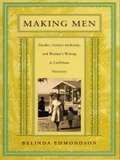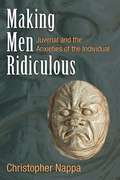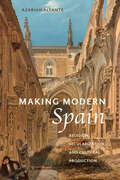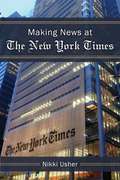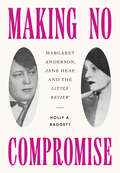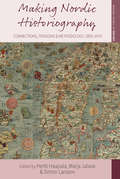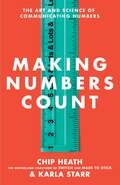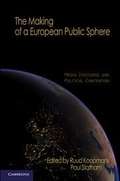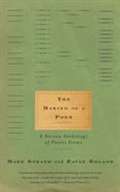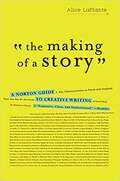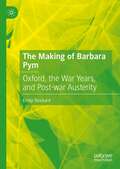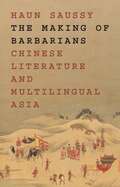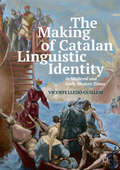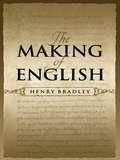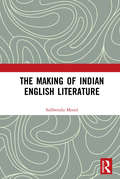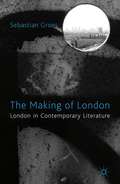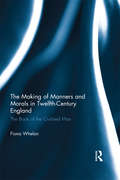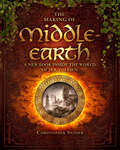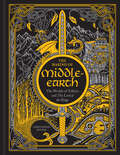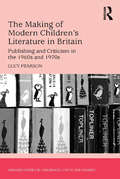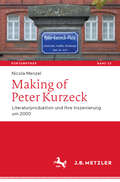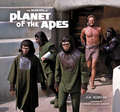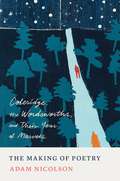- Table View
- List View
Making Men: Gender, Literary Authority, and Women’s Writing in Caribbean Narrative
by Belinda EdmondsonColonialism left an indelible mark on writers from the Caribbean. Many of the mid-century male writers, on the eve of independence, looked to England for their models. The current generation of authors, many of whom are women, have increasingly looked--and relocated--to the United States. Incorporating postcolonial theory, West Indian literature, feminist theory, and African American literary criticism, Making Men carves out a particular relationship between the Caribbean canon--as represented by C. L. R. James and V. S. Naipaul, among others--and contemporary Caribbean women writers such as Jean Rhys, and Jamaica Kincaid, Paule Marshall, and Michelle Cliff, who now live in the United States. Discussing the canonical Caribbean narrative as it reflects national identity under the domination of English cultural authority, Belinda Edmondson focuses particularly on the pervasive influence of Victorian sensibilities in the structuring of twentieth-century national identity. She shows that issues of race and English constructions of masculinity not only are central to West Indian identity but also connect Caribbean authorship to the English literary tradition. This perspective on the origins of West Indian literary nationalism then informs Edmondson's search for female subjectivity in current literature by West Indian women immigrants in America. Making Men compares the intellectual exile of men with the economic migration of women, linking the canonical male tradition to the writing of modern West Indian women and exploring how the latter write within and against the historical male paradigm in the continuing process of national definition. With theoretical claims that invite new discourse on English, Caribbean, and American ideas of exile, migration, race, gender identity, and literary authority, Making Men will be informative reading for those involved with postcolonial theory, African American and women's studies, and Caribbean literature.
Making Men Ridiculous: Juvenal and the Anxieties of the Individual
by Christopher NappaWriting during the reign of emperors Trajan and Hadrian, Juvenal drew on Roman legend and the history of preceding imperial dynasties as a means of scrutinizing cultural upheavals in the Rome of his day. Tacky foreigners, the nouveaux riches, women who don’t know their place, bloodthirsty—even crazy—emperors and their (often worse) wives confront the reader at every turn, along with bad poets, corrupt aristocrats, gladiators, whores, false philosophers, sad-sack men in the street, and slaves. Juvenal’s poetry set the tone, and often the topics, for satirists throughout the centuries of European literature. In his sixteen verse satires, Juvenal presents speakers who decry the breakdown in traditional Roman values and the status of Roman men as they are confronted by upstart foreigners, devious and deviant women, class traitors, the power of the imperial household, and even the body itself. The satirist castigates vice and immorality even as he revels in describing them. This book locates Juvenal’s targets among the matrices of birth, wealth, class, gender, and ethnicity and walks carefully through a number of his most arresting vignettes in order to show not only what, but how, he satirizes. Moreover, the analysis shows that Juvenal’s portraits sometimes escape his grasp, and, as often as not, he ends up undermining the voice with which he speaks and the values he claims to hold dear. Individual chapters look at the satirist himself, rebellious bodies, disgraced aristocrats, uppity (even murderous) wives, and the necessary but corrupting power of money. The conclusion considers the endurance of both the targets and the rhetoric behind them in the modern world. Making Men Ridiculous will interest scholars and advanced students of ancient satire, later European satire, imperial Roman culture and literature, and class, gender, and sexuality in the ancient world.
Making Modern Spain: Religion, Secularization, and Cultural Production (Campos Ibéricos: Bucknell Studies in Iberian Literatures and Cultures)
by Azariah AlfanteIn this elegantly written study, Alfante explores the work of select nineteenth-century writers, intellectuals, journalists, politicians, and clergy who responded to cultural and spiritual shifts caused by the movement toward secularization in Spain. Focusing on the social experience, this book probes the tensions between traditionalism and liberalism that influenced public opinion of the clergy, sacred buildings, and religious orders. The writings of Cecilia Böhl de Faber (Fernán Caballero), Gustavo Adolfo Bécquer, Benito Pérez Galdós, and José María de Pereda addressed conflicts between modernizing forces and the Catholic Church about the place of religion and its signifiers in Spanish society. Foregrounding expropriation (government confiscation of civil and ecclesiastical property) and exclaustration (the expulsion of religious communities), and drawing on archival research, the history of disentailment, cultural theory, memory studies, and sociology, Alfante demonstrates how Spain’s liberalizing movement profoundly influenced class mobility and faith among the populace.
Making National News
by Gene AllenFor almost a century, Canadian newspapers, radio and television stations, and now internet news sites have depended on the Canadian Press news agency for most of their Canadian (and, through its international alliances) foreign news. This book provides the first-ever scholarly history of CP, as well as the most wide-ranging historical treatment of twentieth-century Canadian journalism published to date.Using extensive archival research, including complete and unfettered access to CP's archives, Gene Allen traces how CP was established and evolved in the face of frequent conflicts among the powerful newspaper publishers - John Ross Robertson, Joseph Atkinson, and Roy Thomson, among others - who collectively owned it, and how the journalists who ran it understood and carried out their work. Other major themes include CP's shifting relationships with the Associated Press and Reuters; its responses to new media; its aggressive shaping of its own national role during the Second World War; and its efforts to meet the demands of French-language publishers.Making National News makes a substantial and original contribution to our understanding of journalism as a phenomenon that shaped Canada both culturally and politically in the twentieth century.
Making News At The New York Times
by Nikki UsherMaking News at The New York Times is the first in-depth portrait of the nation's, if not the world's, premier newspaper in the digital age. It presents a lively chronicle of months spent in the newsroom observing daily conversations, meetings, and journalists at work. We see Page One meetings, articles developed for online and print from start to finish, the creation of ambitious multimedia projects, and the ethical dilemmas posed by social media in the newsroom. Here, the reality of creating news in a 24/7 instant information environment clashes with the storied history of print journalism, and the tensions present a dramatic portrait of news in the online world. This news ethnography brings to bear the overarching value clashes at play in a digital news world. The book argues that emergent news values are reordering the fundamental processes of news production. Immediacy, interactivity, and participation now play a role unlike any time before, creating clashes between old and new. These values emerge from the social practices, pressures, and norms at play inside the newsroom as journalists attempt to negotiate the new demands of their work. Immediacy forces journalists to work in a constant deadline environment, an ASAP world, but one where the vaunted traditions of yesterday's news still appear in the next day's print paper. Interactivity, inspired by the new user-computer directed capacities online and the immersive Web environment, brings new kinds of specialists into the newsroom, but exacts new demands upon the already taxed workflow of traditional journalists. And at time where social media presents the opportunity for new kinds of engagement between the audience and media, business executives hope for branding opportunities while journalists fail to truly interact with their readers.
Making No Compromise: Margaret Anderson, Jane Heap, and the "Little Review"
by Holly A. BaggettMaking No Compromise is the first book-length account of the lives and editorial careers of Margaret Anderson and Jane Heap, the women who founded the avant-garde journal the Little Review in Chicago in 1914. Born in the nineteenth-century Midwest, Anderson and Heap grew up to be iconoclastic rebels, living openly as lesbians, and advocating causes from anarchy to feminism and free love. Their lives and work shattered cultural, social, and sexual norms. As their paths crisscrossed Chicago, New York, Paris, and Europe; two World Wars; and a parade of the most celebrated artists of their time, they transformed themselves and their journal into major forces for shifting perspectives on literature and art. Imagism, Dada, surrealism, and Machine Age aesthetics were among the radical trends the Little Review promoted and introduced to US audiences. Anderson and Heap published the early work of the "men of 1914"—Ezra Pound, James Joyce, William Butler Yeats, and T. S. Eliot—and promoted women writers such as Djuna Barnes, May Sinclair, Dorothy Richardson, Mina Loy, Mary Butts, and the inimitable Baroness Elsa von Freytag-Loringhoven. In the mid-1920s Anderson and Heap became adherents of George I. Gurdjieff, a Russian mystic, and in 1929 ceased publication of the Little Review.Holly A. Baggett examines the roles of radical politics, sexuality, modernism, and spirituality and suggests that Anderson and Heap's interest in esoteric questions was evident from the early days of the Little Review. Making No Compromise tells the story of two women who played an important role in shaping modernism.
Making Nordic Historiography: Connections, Tensions and Methodology, 1850-1970
by Pertti Haapala Marja Jalava Simon LarssonIs there a "Nordic history"? If so, what are its origins, its scope, and its defining features? In this informative volume, scholars from all five Nordic nations tackle a notoriously problematic historical concept. Whether recounting Foucault's departure from Sweden or tracing the rise of movements such as "aristocratic empiricism," each contribution takes a deliberately transnational approach that is grounded in careful research, yielding rich, nuanced perspectives on shifting and contested historical terrain.
Making Numbers Count: The Art and Science of Communicating Numbers
by Chip Heath Karla StarrA clear, practical, first-of-its-kind guide to communicating and understanding numbers and data—from bestselling business author Chip Heath.How much bigger is a billion than a million? Well, a million seconds is twelve days. A billion seconds is…thirty-two years. Understanding numbers is essential—but humans aren&’t built to understand them. Until very recently, most languages had no words for numbers greater than five—anything from six to infinity was known as &“lots.&” While the numbers in our world have gotten increasingly complex, our brains are stuck in the past. How can we translate millions and billions and milliseconds and nanometers into things we can comprehend and use? Author Chip Heath has excelled at teaching others about making ideas stick and here, in Making Numbers Count, he outlines specific principles that reveal how to translate a number into our brain&’s language. This book is filled with examples of extreme number makeovers, vivid before-and-after examples that take a dry number and present it in a way that people click in and say &“Wow, now I get it!&” You will learn principles such as: -SIMPLE PERSPECTIVE CUES: researchers at Microsoft found that adding one simple comparison sentence doubled how accurately users estimated statistics like population and area of countries. -VIVIDNESS: get perspective on the size of a nucleus by imagining a bee in a cathedral, or a pea in a racetrack, which are easier to envision than &“1/100,000th of the size of an atom.&” -CONVERT TO A PROCESS: capitalize on our intuitive sense of time (5 gigabytes of music storage turns into &“2 months of commutes, without repeating a song&”). -EMOTIONAL MEASURING STICKS: frame the number in a way that people already care about (&“that medical protocol would save twice as many women as curing breast cancer&”). Whether you&’re interested in global problems like climate change, running a tech firm or a farm, or just explaining how many Cokes you&’d have to drink if you burned calories like a hummingbird, this book will help math-lovers and math-haters alike translate the numbers that animate our world—allowing us to bring more data, more naturally, into decisions in our schools, our workplaces, and our society.
The Making of a European Public Sphere
by Ruud Koopmans Paul StathamThis book investigates an important source of the European Union's recent legitimacy problems. It shows how European integration is debated in mass media, and how this affects democratic inclusiveness. Advancing integration implies a shift in power between governments, parliaments, and civil society. Behind debates over Europe's "democratic deficit" is a deeper concern: whether democratic politics can perform effectively under conditions of Europeanization and globalization. This study is based on a wealth of unique data from seven European countries, combining newspaper content analyses, an innovative study of Internet communication structures, and hundreds of interviews with leading political and media representatives across Europe. It is by far the most far-reaching and empirically grounded study on the Europeanization of media discourse and political contention to date, and a must-read for anyone interested in how European integration changes democratic politics and why European integration has become increasingly contested.
The Making of a Poem: A Norton Anthology of Poetic Forms
by Mark Strand Eavan BolandThis anthology illuminates the history, practice, and wonder of our most elusive art. Intended for all those who love poetry, the anthology draws the reader into the excitement and entertainment of various poetic forms
The Making of a Story: A Norton Guide to Creative Writing
by Alice LaPlanteThe Making of a Story is a fresh and inspiring guide to the basics of creative writing―both fiction and creative nonfiction. Its hands-on, completely accessible approach walks writers through each stage of the creative process, from the initial triggering idea to the revision of the final manuscript. It is unique in combing the three main aspects of creative writing instruction: process (finding inspiration, getting ideas on the page), craft (specific techniques like characterization), and anthology (learning by reading masters of the form). Succinct, clear definitions of basic terms of fiction are accompanied by examples, including excerpts from masterpieces of short fiction and essays as well as contemporary novels. A special highlight is Alice LaPlante's systematic debunking of many of the so-called rules of creative writing. <p><p> This book is perfect for writers working alone as well as for creative writing classes, both introductory and advanced.
The Making of Barbara Pym: Oxford, the War Years, and Post-war Austerity
by Emily StockardThe Making of Barbara Pym offers new insights into Pym’s formative years as a writer, during which she honed a complex view of the necessity of change on individual and cultural levels. Supported by newly published archival material, this comprehensive study of Pym’s early work explores her personal and fictional pre-war and wartime writing, including unpublished and posthumously published works, before looking closely at Some Tame Gazelle and Excellent Women, published during Britain’s post-war austerity period. Of central importance is a new recognition of Pym’s use of social roles, particularly those of women, as proper avenues for change. The book traces how Pym came to devise characters whose individual development can be seen as analogous to or representative of larger cultural movements. Pym uses the spinster figure to embody the forward-looking cultural perspectives that she endorsed and then, finally, in Jane and Prudence, to figure the end of Britain’s austerity period.
The Making of Barbarians: Chinese Literature and Multilingual Asia (Translation/Transnation #58)
by Haun SaussyA groundbreaking account of translation and identity in the Chinese literary tradition before 1850—with important ramifications for todayDebates on the canon, multiculturalism, and world literature often take Eurocentrism as the target of their critique. But literature is a universe with many centers, and one of them is China. The Making of Barbarians offers an account of world literature in which China, as center, produces its own margins. Here Sinologist and comparatist Haun Saussy investigates the meanings of literary translation, adaptation, and appropriation on the boundaries of China long before it came into sustained contact with the West.When scholars talk about comparative literature in Asia, they tend to focus on translation between European languages and Chinese, Korean, and Japanese, as practiced since about 1900. In contrast, Saussy focuses on the period before 1850, when the translation of foreign works into Chinese was rare because Chinese literary tradition overshadowed those around it.The Making of Barbarians looks closely at literary works that were translated into Chinese from foreign languages or resulted from contact with alien peoples. The book explores why translation was such an undervalued practice in premodern China, and how this vast and prestigious culture dealt with those outside it before a new group of foreigners—Europeans—appeared on the horizon.
The Making of Catalan Linguistic Identity in Medieval and Early Modern Times
by Vicente Lledó-GuillemThe historical relationship between the Catalan and Occitan languages had a definitive impact on the linguistic identity of the powerful Crown of Aragon and the emergent Spanish Empire. Drawing upon a wealth of historical documents, linguistic treatises and literary texts, this book offers fresh insights into the political and cultural forces that shaped national identities in the Iberian Peninsula and, consequently, neighboring areas of the Mediterranean during the Middle Ages and the Early Modern Period. The innovative textual approach taken in these pages exposes the multifaceted ways in which the boundaries between the region’s most prestigious languages were contested, and demonstrates how linguistic identities were linked to ongoing struggles for political power. As the analysis reveals, the ideological construction of Occitan would play a crucial role in the construction of a unified Catalan, and Catalan would, in turn, give rise to a fervent debate around ‘Spanish’ language that has endured through the present day. This book will appeal to students and scholars of historical linguistics, sociolinguistics, Hispanic linguistics, Catalan language and linguistics, anthropological linguistics, Early Modern literature and culture, and the history of the Mediterranean.
The Making of English
by Henry BradleyThis etymological tour de force was written by a self-taught farmer's son who became a world-famous linguist and senior editor of the Oxford English Dictionary. By the time he was a teenager, Henry Bradley (1845-1923) had immersed himself in several classical languages. His achievements were ultimately recognized with honorary degrees from Oxford and Heidelberg, and fellowships at Magdalen College and the British Academy. This 1904 work represents the culmination of his philological career.Scholarly yet nontechnical, The Making of English explains in simple terms the relationships between English and other tongues--Greek, Latin, German, Spanish, and French. Topics include the similarities and differences between English and German, characteristics of Old English, and the composition, derivation, and root-creation involved in the process of the making of words. The author also discusses changes in meaning that occur over time, and profiles some historical figures who were influential in shaping the English language.
The Making of Indian English Literature
by Subhendu MundThe Making of Indian English Literature brings together seventeen well-researched essays of Subhendu Mund with a long introduction by the author historicising the development of the Indian writing in English while exploring its identity among the many appellations tagged to it. The volume demonstrates, contrary to popular perceptions, that before the official introduction of English education in India, Indians had already tried their hands in nearly all forms of literature: poetry, fiction, drama, essay, biography, autobiography, book review, literary criticism and travel writing. Besides translation activities, Indians had also started editing and publishing periodicals in English before 1835. Through archival research the author brings to discussion a number of unknown and less discussed texts which contributed to the development of the genre. The work includes exclusive essays on such early poets and writers as Kylas Chunder Dutt, Shoshee Chunder Dutt, Toru Dutt, Mirza Moorad Alee Beg, Krupabai Satthianadhan, Swami Vivekananda, H. Dutt, and Sita Chatterjee; and historiographical studies on the various aspects of the genre. The author also examines the strategies used by the early writers to indianise the western language and the form of the novel. The present volume also demonstrates how from the very beginning Indian writing in English had a subtle nationalist agenda and created a space for protest literature. The Making of Indian English Literature will prove an invaluable addition to the studies in Indian writing in English as a source of reference and motivation for further research. Please note: Taylor & Francis does not sell or distribute the Hardback in India, Pakistan, Nepal, Bhutan, Bangladesh and Sri Lanka.
The Making of Jane Austen
by Devoney LooserAn engaging account of how Jane Austen became a household name.Just how did Jane Austen become the celebrity author and the inspiration for generations of loyal fans she is today? Devoney Looser's The Making of Jane Austen turns to the people, performances, activism, and images that fostered Austen's early fame, laying the groundwork for the beloved author we think we know. Here are the Austen influencers, including her first English illustrator, the eccentric Ferdinand Pickering, whose sensational gothic images may be better understood through his brushes with bullying, bigamy, and an attempted matricide. The daring director-actress Rosina Filippi shaped Austen's reputation with her pioneering dramatizations, leading thousands of young women to ventriloquize Elizabeth Bennet's audacious lines before drawing room audiences. Even the supposedly staid history of Austen scholarship has its bizarre stories. The author of the first Jane Austen dissertation, student George Pellew, tragically died young, but he was believed by many, including his professor-mentor, to have come back from the dead.Looser shows how these figures and their Austen-inspired work transformed Austen's reputation, just as she profoundly shaped theirs. Through them, Looser describes the factors and influences that radically altered Austen's evolving image. Drawing from unexplored material, Looser examines how echoes of that work reverberate in our explanations of Austen's literary and cultural power. Whether you're a devoted Janeite or simply Jane-curious, The Making of Jane Austen will have you thinking about how a literary icon is made, transformed, and handed down from generation to generation.
The Making of London
by Sebastian GroesLondon has become the focus of a ferocious imaginative energy since the rise of Thatcher. The Making of London analyses the body of work by writers who have committed their writing to the many lives of a city undergoing complex transformations, tracing a major shift in the representation of the capital city.
The Making of Manners and Morals in Twelfth-Century England: The Book of the Civilised Man
by Fiona WhelanHow different are we from those in the past? Or, how different do we think we are from those in the past? Medieval people were more dirty and unhygienic than us – as novels, TV, and film would have us believe – but how much truth is there in this notion? This book seeks to challenge some of these preconceptions by examining medieval society through rules of conduct, and specifically through the lens of a medieval Latin text entitled The Book of the Civilised Man – or Urbanus magnus – which is attributed to Daniel of Beccles. Urbanus magnus is a twelfth-century poem of almost 3,000 lines which comprehensively surveys the day-to-day life of medieval society, including issues such as moral behaviour, friendship, marriage, hospitality, table manners, and diet. Currently, it is a neglected source for the social and cultural history of daily life in medieval England, but by incorporating modern ideas of disgust and taboo, and merging anthropology, sociology, and archaeology with history, this book aims to bring it to the fore, and to show that medieval people did have standards of behaviour. Although they may seem remote to modern ‘civilised’ people, there is both continuity and change in human behaviour throughout the centuries.
The Making of Middle-Earth: A New Look Inside the World of J. R. R. Tolkien
by Christopher A. SnyderThis study “adds an important voice to the growing body of Tolkien scholarship,” covering the author’s life, influences, and original mythology (The Boston Globe).J. R. R. Tolkien’s epic fantasy adventure, The Lord of the Rings, is universally regarded as one of history’s best-loved literary works. Now medieval scholar and Tolkien expert Christopher Snyder presents the most in-depth exploration yet of Tolkien’s source materials for Middle-earth—from the languages, poetry, and mythology of medieval Europe and ancient Greece to the halls of Oxford and the battlefields of World War I. Fueled by the author’s passion for all things Tolkien, this richly illustrated book also reveals the surprisingly pervasive influence of Tolkien’s timeless fantasies on modern culture.
The Making of Middle-earth: The Worlds of Tolkien and The Lord of the Rings
by Christopher A. SnyderThis volume is perhaps the most in-depth exploration ever undertaken of Tolkien's world. Accessible but authoritative, and fully illustrated, it is now being reissued with a stunning new cover treatment and updated commentary on new books, films, games, and shows. This book, originally published in 2013 and richly illustrated with photographs and artwork , was the first to connect all the threads of influence on Tolkien that infused his creation of Middle-earth—from the languages, poetry, and mythology of medieval Europe and ancient Greece and Rome to the halls of Oxford and the battlefields of World War I. Snyder examines the impact of these works on our modern culture, from 1960s counterculture to fantasy publishing, gaming, music, and beyond. The reissue has a gorgeous, updated cover design with a custom illustration on foil-stamped faux cloth and additional pages of material covering new developments.
The Making of Modern Children's Literature in Britain: Publishing and Criticism in the 1960s and 1970s (Studies in Childhood, 1700 to the Present)
by Lucy PearsonLucy Pearson’s lively and engaging book examines British children’s literature during the period widely regarded as a ’second golden age’. Drawing extensively on archival material, Pearson investigates the practical and ideological factors that shaped ideas of ’good’ children’s literature in Britain, with particular attention to children’s book publishing. Pearson begins with a critical overview of the discourse surrounding children’s literature during the 1960s and 1970s, summarizing the main critical debates in the context of the broader social conversation that took place around children and childhood. The contributions of publishing houses, large and small, to changing ideas about children’s literature become apparent as Pearson explores the careers of two enormously influential children’s editors: Kaye Webb of Puffin Books and Aidan Chambers of Topliner Macmillan. Brilliant as an innovator of highly successful marketing strategies, Webb played a key role in defining what were, in her words, ’the best in children’s books’, while Chambers’ work as an editor and critic illustrates the pioneering nature of children's publishing during this period. Pearson shows that social investment was a central factor in the formation of this golden age, and identifies its legacies in the modern publishing industry, both positive and negative.
Making of Peter Kurzeck: Literaturproduktion und ihre Inszenierung um 2000 (Kontemporär. Schriften zur deutschsprachigen Gegenwartsliteratur #22)
by Nicola MenzelDie Studie untersucht die öffentliche Darstellung des Schreibprozesses Peter Kurzecks. Seine mehrbändige autofiktionale Romanreihe Das alte Jahrhundert sowie seine frei eingesprochenen Hörbücher wurden im Feuilleton einhellig als außergewöhnlich besprochen. Sie gelten als authentische Rarität in einem sich ansonsten zunehmend popularisierendem Literaturbetrieb. Die Arbeit zeigt hingegen, dass das Phänomen Kurzeck keinesfalls abseits eines ökonomisierten und medialisierten gegenwartskulturellen Feldes steht. Vielmehr lassen sich typische populäre und ökonomische Mechanismen ablesen wie u.a. Mehrfachadressierung, Zweitverwertung, Serialität und Fankultur. Auch das Phänomen Kurzeck selbst wirkt auf das Feld ein, von dem es sich abzusondern scheint, und zwar nicht trotz des autonomieästhetischen Gestus, sondern gerade deswegen. Kurzeck wird mithin als gegenwartsästhetisches Phänomen untersucht, bei dem Marktdistinktion zum Verkaufsargument wird.Exemplarisch an Kurzeck wird gezeigt, dass sich Formationen des gegenwartskulturellen Feldes um 2000 auch dort ablesen lassen, wo sie nicht erwartet werden. Die Arbeit regt dazu an, einen emphatischen Literaturbegriff als grundsätzlich produzierbar und konsumierbar zu verstehen, mit Blick auf Kurzeck als werkpolitischer Effekt der Selbst- und Schreibdarstellung einer Autorfigur. Als Beitrag zur Gegenwartsliteraturforschung regt sie darüber hinaus zur Reflexion der literaturwissenschaftlichen Haltung gegenüber ihrem Gegenstand und den eigenen Forschungspraktiken an.Methodisch verbindet sie feldtheoretische Fragen mit close readings nicht nur literarischer Texte und ihrer Vorarbeiten aus dem Nachlass Kurzecks, sondern auch von Interviews, Preisreden, Videoaufnahmen von Lesungen, einem öffentlichen Manuskriptdiktat im Frankfurter Literaturhaus sowie der Peter-Kurzeck-App. Das dafür entwickelte umfassende methodische Modell stellt einen generellen Vorschlag dar zur Analyse gegenwartsliterarischer Gegenstände, bei der literaturwissenschaftliche Methoden mit ökonomischen, paratextuellen, soziologischen, praxeologischen und kulturästhetischen Aspekten im Dialog stehen.
The Making of Planet of the Apes
by Jonathan RinzlerFOREWORD BY FRASER HESTONIn celebration of the fiftieth anniversary of Planet of the Apes, the classic science-fiction film from 1968, The Making of Planet of the Apes tells the film and offers exclusive, never-before-seen photographs and concept art.Based on Pierre Boulle's novel La Planéte de singes, the original Planet of the Apes was one of the most celebrated films of the 1960s and beyond. Starring Hollywood icons Charlton Heston and Roddy McDowall, the movie struck a chord with the world and sparked a franchise that included eight sequels, two television series, and a long-running comic book. Now, five decades after its theatrical release, New York Times bestselling author J. W. Rinzler tells the thrilling story of this legendary Hollywood production—a film even Boulle thought would be impossible to make.With a foreword by Fraser Heston, Charlton Heston's son, The Making of Planet of the Apes is an entertaining, informative experience that will transport readers back to the strange alternate Earth ruled by apes, and bring to life memorable characters such as Cornelius, Dr. Zira, Dr. Zaius, and Taylor, the human astronaut whose time-traveling sparks an incredible adventure. Meticulously researched and designed to capture the look and atmosphere of the film, The Making of Planet of the Apes is also packed with a wealth of concept paintings, storyboards, and never-before-seen imagery—including rare journal pages and sketches from Charlton Heston's private collection—as well as color and black-and-white unit photography, posters, and more unique ephemera.Comprehensive in scope, The Making of Planet of the Apes is the definitive look at the original blockbuster film, a must-have for fans, film buffs, and collectors alike.
The Making of Poetry: Coleridge, the Wordsworths, and Their Year of Marvels
by Adam NicolsonBrimming with poetry, art, and nature writing—Wordsworth and Coleridge as you've never seen them beforeJune 1797 to September 1798 is the most famous year in English poetry. Out of it came Samuel Taylor Coleridge's The Rime of the Ancient Mariner and “Kubla Khan,” as well as his unmatched hymns to friendship and fatherhood, and William Wordsworth’s revolutionary songs in Lyrical Ballads along with “Tintern Abbey,” Wordsworth's paean to the unity of soul and cosmos, love and understanding.In The Making of Poetry, Adam Nicolson embeds himself in the reality of this unique moment, exploring the idea that these poems came from this particular place and time, and that only by experiencing the physical circumstances of the year, in all weathers and all seasons, at night and at dawn, in sunlit reverie and moonlit walks, can the genesis of the poetry start to be understood.The poetry Wordsworth and Coleridge made was not from settled conclusions but from the adventure on which they embarked, thinking of poetry as a challenge to all received ideas, stripping away the dead matter, looking to shed consciousness and so change the world. What emerges is a portrait of these great figures seen not as literary monuments but as young men, troubled, ambitious, dreaming of a vision of wholeness, knowing they had greatness in them but still in urgent search of the paths toward it.The artist Tom Hammick accompanied Nicolson for much of the year, making woodcuts from the fallen timber in the park at Alfoxden where the Wordsworths lived. Interspersed throughout the book, his images bridge the centuries, depicting lives at the source of our modern sensibility: a psychic landscape of doubt and possibility, full of beauty and thick with desire for a kind of connectedness that seems permanently at hand and yet always out of reach.
